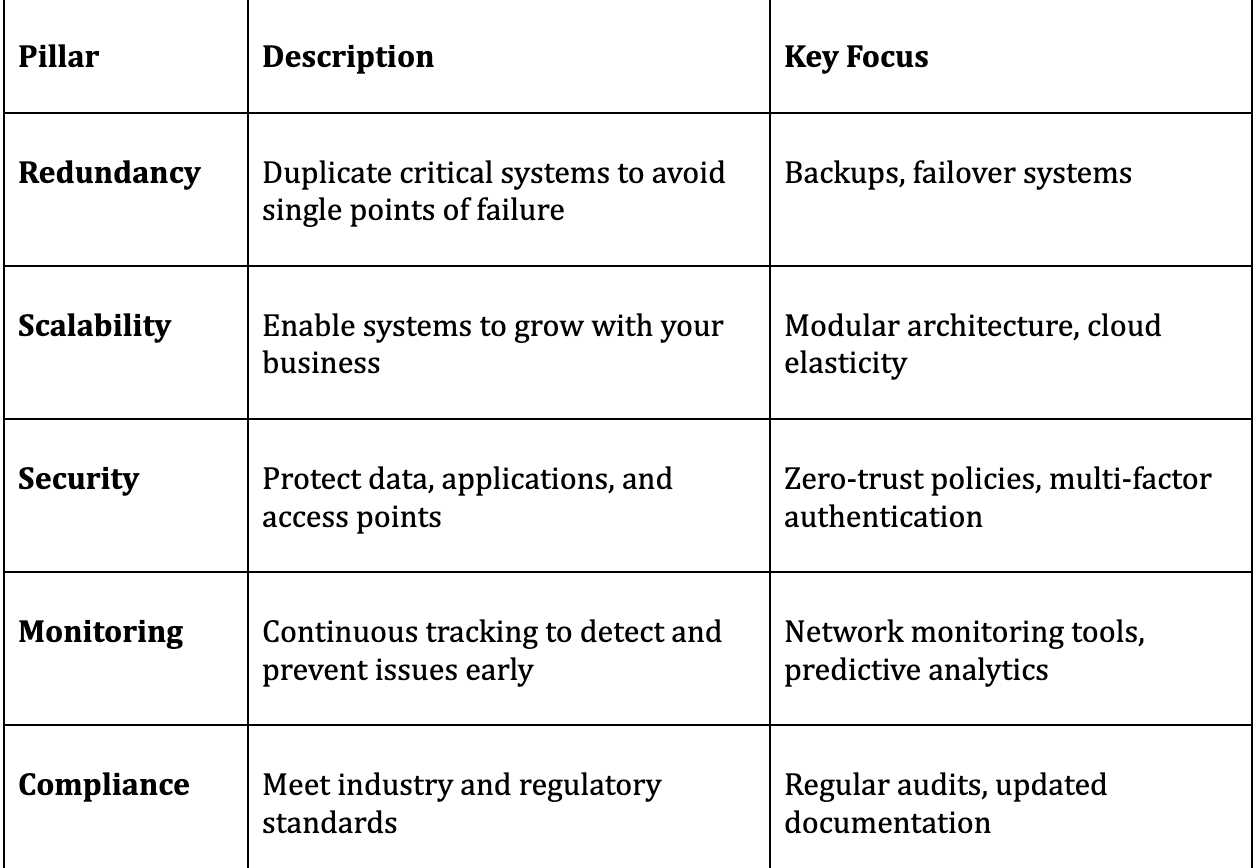Building Digital Resilience: How to Future-Proof Your Business’s IT Infrastructure in Uncertain Times
In today’s unpredictable digital landscape, every business—whether a startup or a global enterprise—depends on reliable IT systems. Unexpected challenges like cyberattacks, power outages, or supply chain disruptions can cripple operations overnight. A strong IT infrastructure isn’t just a technology investment; it’s an operational lifeline.
Key Points
To fortify your IT infrastructure, prioritize risk-aware planning, consistent updates, and smart partnerships. Combine automation, secure cloud solutions, and expert consulting to create a resilient ecosystem capable of adapting to change.
Why IT Resilience Matters
Businesses face increasing pressure to stay online 24/7. From natural disasters to sudden market shifts, disruptions happen without warning. A resilient IT infrastructure helps your organization:
- Minimize downtime and data loss
- Maintain productivity under stress
- Protect reputation and customer trust
- Scale efficiently as new technologies emerge
For additional strategies on disaster recovery frameworks, explore IBM’s Business Continuity Guide.

For an overview of compliance frameworks, visitthe NIST Cybersecurity Framework.
How to Strengthen Your IT Infrastructure
1) Audit and Assess
- Review existing hardware, software, and data flow.
- Identify outdated systems and potential vulnerabilities.
- Use tools likeSolarWinds Network Performance Monitor for network mapping.
1) Upgrade and Secure
- Move to hybrid or multi-cloud solutions for flexibility.
- Implement encrypted communication channels and secure access controls.
3) Establish Backup and Recovery Protocols
- Automate backups and test restoration regularly.
- Store copies both onsite and offsite using secure cloud repositories likeBackblaze B2 Cloud Storage.
4) Train and Empower Your Team
- Educate staff on cybersecurity best practices.
- Use simulated drills to prepare for emergencies.
5) Partner with Experts
- Engage consultants who specialize in system optimization and resilience planning.
ContactOut can help you source and connect with qualified specialists through accurate, up-to-date contact information.
Engage Strategic IT Consulting
Partnering with experienced consultants can transform your IT environment from reactive to resilient. External experts bring structured methodologies and insights into risk assessment, infrastructure modernization, and operational streamlining.
When navigating uncertainty, collaborating with a firm likeOlive + Ash Design ensures that your business gains tailored strategies for infrastructure strength and seamless continuity—keeping your systems reliable even during the unexpected.
Using Machine Vision for Smarter IT Operations
Adopting applications of machine vision technology can significantly improve infrastructure monitoring. These systems integrate automation and real-time analytics to detect anomalies, optimize performance, and support rapid response to system failures.
Because successful deployment depends on powerful and durable computing hardware, using industrial-grade systems, such as those designed for machine vision solutions, ensures consistent real-time data processing and long-term operational durability.
Checklist: IT Infrastructure Resilience Essentials
✅ Conduct a full system audit annually
✅ Implement cloud redundancy
✅ Encrypt sensitive data in transit and at rest
✅ Train employees in cybersecurity hygiene
✅ Test recovery protocols quarterly
✅ Partner with trusted IT consultants
✅ Regularly update all devices and firmware
For more detailed security readiness frameworks, consult theCenter for Internet Security Controls.
FAQs
Q1: How often should IT systems be reviewed?
At least once a year, or immediately after major system changes or security incidents.
Q2: What’s the biggest threat to IT infrastructure today?
Human error remains a major risk, alongside evolving cyber threats and misconfigured cloud systems.
Q3: How do I ensure my cloud provider is reliable?
Look for transparent uptime records, compliance certifications, and disaster recovery capabilities.
Q4: What’s the difference between business continuity and disaster recovery?
Continuity covers keeping operations running; recovery focuses on restoring data and systems after a failure.
Q5: What are the early signs of IT infrastructure weakness?
Frequent downtime, slow data access, inconsistent system updates, or poor integration between tools.
Product Spotlight: Fortinet Secure Network Fabric
If you’re seeking an integrated approach to network security, Fortinet’s Security Fabric offers a scalable architecture that connects endpoints, cloud systems, and remote users under one unified security strategy. Its flexibility helps businesses safeguard evolving hybrid environments without overwhelming complexity.
Glossary
- Redundancy: System duplication for fail-safe operation.
- Disaster Recovery (DR): Protocols to restore IT systems after a disruption.
- Hybrid Cloud: A computing environment combining private and public clouds.
- Zero Trust: A cybersecurity model requiring verification for all users.
- Scalability: The system’s ability to handle increased workloads smoothly.
Conclusion
A resilient IT infrastructure isn’t built overnight—it’s cultivated through consistent upgrades, proactive management, and expert guidance. By combining clear strategy, reliable technology, and continuous improvement, your business can thrive no matter how unpredictable the world becomes.




















